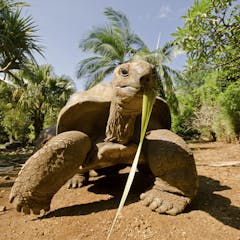
Articles on Grasslands
Displaying 1 - 20 of 37 articles

Even with the best intentions, policies from different government departments can clash.

Knowing which parts of Africa best help to store carbon means funding and policy efforts can be directed to protecting and increasing this carbon ‘land sink’.

The state’s largest wildfire on record tore across the heart of Texas cattle country, and more days of strong winds were forecast. A rangeland ecologist explains why the flames spread so fast.

Re-wilding Madagascar with giant tortoises last found on the island 600 years ago could help the island mitigate climate change.

The successful quest to find a species last seen more than 50 years ago has added to the urgency of protecting the vanishing grassland habitat of a lizard that had been feared extinct.

Butterflies are sentinel species – their interactions with landscapes help scientists understand other insects better.

Governments and wildlife advocates are working to protect 30% of Earth’s lands and waters for nature by 2030. An ecologist explains why creating large protected areas should be a top priority.

Contrary to the idea that apes evolved their upright posture to reach for fruit in the forest canopy, the earliest known ape with this stature, Morotopithecus, lived in more open grassy environments.

Reservoirs and streams are in good shape in California and the Great Basin, but groundwater and ecosystems are another story. And then there’s the Colorado River Basin.

Plus, why you should always remove grass cuttings from your lawn.

Growing native grasses as cattle forage is an example of working lands conservation – balancing human use of the land with conservation goals.

Fire must be allowed to play its natural role.

Maintaining ecological balance in savannas is essential

Efforts to preserve biodiversity and slow climate change make natural bedfellows.

Humanity’s biggest challenges are not technical, but social, economic, political and behavioural. Effective actions are still possible to stabilise the climate and the planet, but must be taken now.

The electric Pokemon’s real-life muse is charged with degrading the vast meadows of the Tibetan Plateau.

Hundreds of computer simulations point to a few best strategies for keeping homes safe from fire in a warming climate.

Large-scale tree-planting projects are politically popular and media-friendly, but without effective planning and long-term management, they can do more harm than good.

Large areas targeted for forest restoration in Africa are covered by savanna and grassland, which provide important ecosystem services that would be lost should they be converted to forests.

As in humans, environmental changes provoked chimpanzees to develop a diverse range of behaviours.
